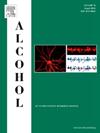The Majchrowicz binge model of alcohol dependence: A valid model for comparing male and female rats
IF 2.9
4区 医学
Q3 PHARMACOLOGY & PHARMACY
引用次数: 0
Abstract
Alcohol use disorders (AUD) among women have steadily risen over the past decade. This increase is due in part to increased rates of drinking among some populations of women, yet relatively little is known about alcohol in women. Until recently, the majority of clinical and preclinical studies investigating AUD have focused on these effects in males, including in the Majchrowicz binge model of alcohol dependence. Therefore, the objective of this study was to perform a retrospective analysis of intoxication behavior and withdrawal severity in adult male and female Sprague Dawley rats using the Majchrowicz model. Rats were gavaged intragastrically with ethanol diet every 8 h for 4 days with doses titrated based on the rat's intoxication behavior. Ten hours after the final dose of alcohol, withdrawal behavior was assessed for 17 h. Males were slightly more intoxicated behaviorally than females, which resulted in females receiving a slightly larger dose of ethanol per day. Despite these differences in intoxication behavior, similar blood ethanol concentrations (BECs) and withdrawal behaviors were observed for males and females. Altogether, these data suggest that while slight differences in intoxication and therefore dosing occur in the Majchrowicz model of alcohol dependence, the model reliably produces similar BECs and minimizes differences in withdrawal severity. This is further supported by a principal component analysis, which confirmed moderate overlap between sexes based on these parameters. Thus, this model is useful for making direct comparisons between groups, and here between sexes, where slight differences in ethanol pharmacokinetics are known to occur.
酒精依赖的Majchrowicz暴饮模型:一个比较雄性和雌性大鼠的有效模型。
女性酒精使用障碍(AUD)在过去十年中稳步上升。这一增长的部分原因是某些女性群体的饮酒率上升,但对女性饮酒的了解相对较少。直到最近,大多数调查AUD的临床和临床前研究都集中在男性的这些影响上,包括酒精依赖的Majchrowicz狂欢模型。因此,本研究的目的是使用Majchrowicz模型对成年雄性和雌性Sprague Dawley大鼠的中毒行为和戒断严重程度进行回顾性分析。大鼠每8小时灌胃一次乙醇饲料,连续灌胃4天,剂量根据大鼠的中毒行为而定。在最后一剂酒精10小时后,对戒断行为进行了17小时的评估。雄性在行为上比雌性更陶醉,这导致雌性每天接受的乙醇剂量略大。尽管在中毒行为上存在这些差异,但在男性和女性中观察到相似的血乙醇浓度(BECs)和戒断行为。总之,这些数据表明,尽管Majchrowicz酒精依赖模型中出现了轻微的中毒和剂量差异,但该模型可靠地产生了相似的BECs,并将戒断严重程度的差异降至最低。主成分分析进一步支持了这一点,根据这些参数证实了两性之间的适度重叠。因此,这个模型对于在不同组之间进行直接比较是有用的,在性别之间,乙醇药代动力学的细微差异是已知的。
本文章由计算机程序翻译,如有差异,请以英文原文为准。
求助全文
约1分钟内获得全文
求助全文
来源期刊

Alcohol
医学-毒理学
CiteScore
4.60
自引率
4.30%
发文量
74
审稿时长
15.6 weeks
期刊介绍:
Alcohol is an international, peer-reviewed journal that is devoted to publishing multi-disciplinary biomedical research on all aspects of the actions or effects of alcohol on the nervous system or on other organ systems. Emphasis is given to studies into the causes and consequences of alcohol abuse and alcoholism, and biomedical aspects of diagnosis, etiology, treatment or prevention of alcohol-related health effects.
Intended for both research scientists and practicing clinicians, the journal publishes original research on the neurobiological, neurobehavioral, and pathophysiological processes associated with alcohol drinking, alcohol abuse, alcohol-seeking behavior, tolerance, dependence, withdrawal, protracted abstinence, and relapse. In addition, the journal reports studies on the effects alcohol on brain mechanisms of neuroplasticity over the life span, biological factors associated with adolescent alcohol abuse, pharmacotherapeutic strategies in the treatment of alcoholism, biological and biochemical markers of alcohol abuse and alcoholism, pathological effects of uncontrolled drinking, biomedical and molecular factors in the effects on liver, immune system, and other organ systems, and biomedical aspects of fetal alcohol spectrum disorder including mechanisms of damage, diagnosis and early detection, treatment, and prevention. Articles are published from all levels of biomedical inquiry, including the following: molecular and cellular studies of alcohol''s actions in vitro and in vivo; animal model studies of genetic, pharmacological, behavioral, developmental or pathophysiological aspects of alcohol; human studies of genetic, behavioral, cognitive, neuroimaging, or pathological aspects of alcohol drinking; clinical studies of diagnosis (including dual diagnosis), treatment, prevention, and epidemiology. The journal will publish 9 issues per year; the accepted abbreviation for Alcohol for bibliographic citation is Alcohol.
 求助内容:
求助内容: 应助结果提醒方式:
应助结果提醒方式:


